google GOOGLE LOOKML DEVELOPER Exam Questions
Questions for the GOOGLE LOOKML DEVELOPER were updated on : Jul 02 ,2025
Page 1 out of 4. Viewing questions 1-15 out of 50
Question 1
A LookML developer creates a new model and a test dashboard from the model. The developer shares the link to the new
dashboard with users, but the users report that all they see is the Model Not Found error.
What is a possible cause of this issue?
- A. The developer has not pushed the new model to Production Mode.
- B. The developer has not added users to the new model set.
- C. The users do not have permission to access this dashboard.
- D. The new model is missing an Explore definition.
Answer:
B
Question 2
A retail company wants to limit who can see the financial information in their reports to executives and store managers. The
LookML Developer creates a user attribute called leadership with the value 000 for executives and 999 for store
managers. The developer creates three access grant objects and one dimension: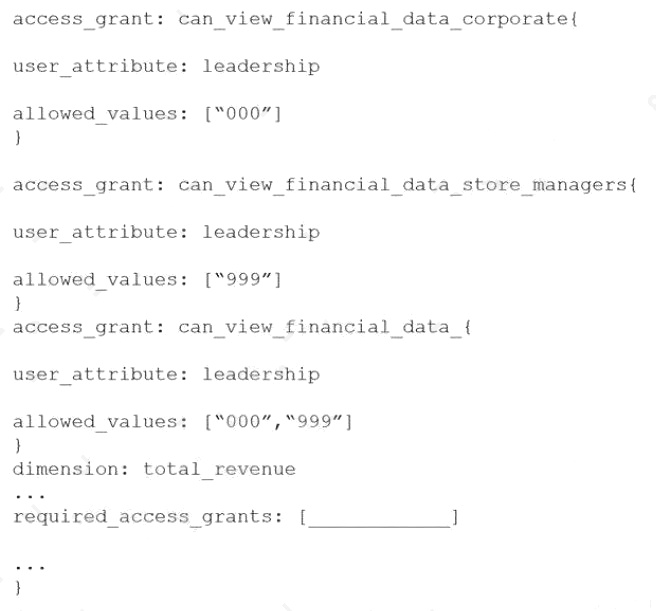
How should the developer ensure that only authorized users see the data in the Total Revenue dimension?
- A. required_access_grants: [can_view_financial_data]
- B. required_access_grants: [leadership]
- C. required_access_grants: [“000”,“999”]
- D. required_access_grants: [total_revenue]
Answer:
A
Explanation:
Reference: https://community.looker.com/technical-tips-tricks-1021/how-to-use-and-troubleshoot-access-grants-field-
permissions-23986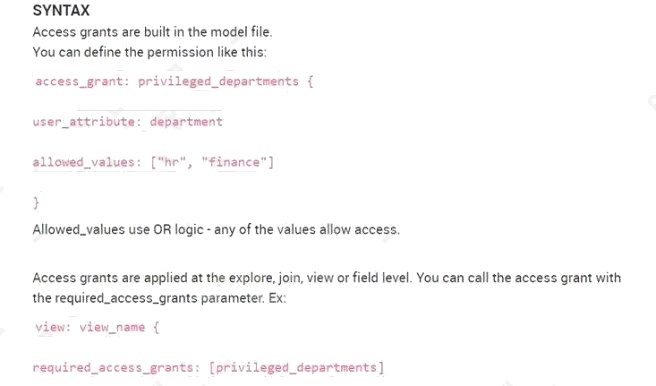
Question 3
Business users report that an ephemeral derived table tile on the dashboard is slow.
Information about the dashboard includes:
The dashboard filter is linked to the user attributes.
This tile usually takes approximately 5 minutes to complete running.
Which solution should be used to improve the dashboard load time?
- A. Use a conditional WHERE clause for Development Mode.
- B. Build a user attribute filter into the Explore.
- C. Use index distribution_key or sort_key for this derived table.
- D. Persist the derived table.
Answer:
D
Explanation:
Reference: https://docs.looker.com/reference/dashboard-reference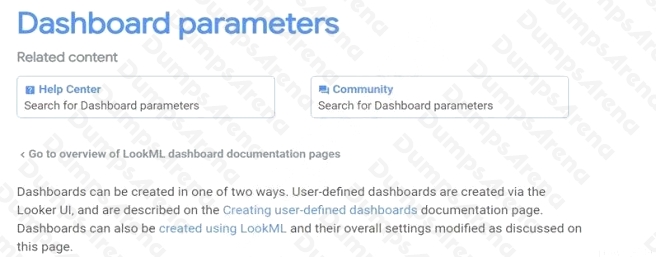
Question 4
A user needs to create a report that shows a count of all orders and of orders over $100.
Which solution should the developer implement to meet these requirements?
- A. An always_filter parameter
- B. A front-end filter in the Explore
- C. A sql_always_where parameter
- D. A filtered measure
Answer:
B
Question 5
Users have built a popular dashboard and want to have change management built in for any edits made to the dashboard.
The developer sets up version control for the model on which the dashboard is based.
What should the developer build to meet the business requirement?
- A. A native derived table based on the dashboard.
- B. A dashboard LookML file included in the project.
- C. A link to the dashboard included in the project.
- D. An Explore LookML file based on the dashboard.
Answer:
B
Explanation:
Reference: https://docs.looker.com/dashboards/creating-lookml-dashboards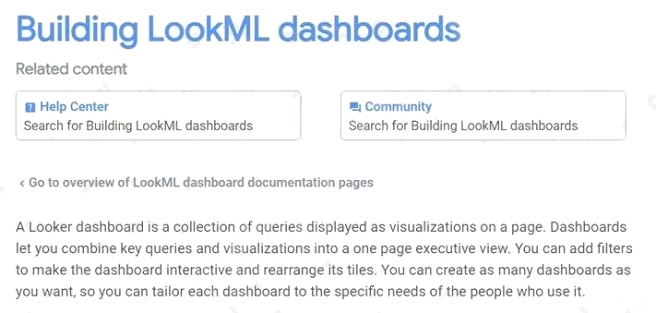
Question 6
Business users report that they are unable to build useful queries because the list of fields in the Explore is too long to find
what they need.
Which three LookML options should a developer use to curate the business users experience? (Choose three.)
- A. Add a description parameter to each field with context so that users can search key terms.
- B. Create a separate project for each business unit containing only the fields that the unit needs.
- C. Add a group_label parameter to relevant fields to organize them into logical categories.
- D. Use the hidden parameter to remove irrelevant fields from the Explore.
- E. Use a derived table to show only the relevant fields.
Answer:
A C E
Question 7
A LookML developer has written the following persistent derived table. It references orders_rollup, another persistent derived
table that also rebuilds with the same SQL trigger value.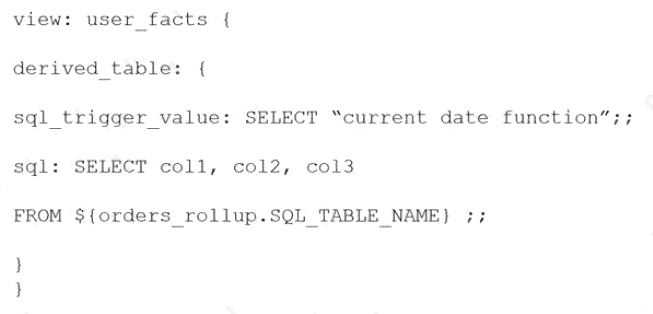
Which change is needed to guarantee that user_facts will always rebuild with the latest data from orders_rollup?
- A. Change the sql_trigger_value parameter of user_facts to select the current date plus one hour, so it triggers an hour after orders_rollup.
- B. Change the orders_rollup view reference to ${orders_rollup.DERVIED_TABLE_NAME}
- C. Change the sql_trigger_value parameter for both persistent derived tables to a datagroup_trigger parameter, and set them to use the same datagroup.
- D. Change the orders_rollup view reference to the literal table name from the database’s scratch schema.
Answer:
C
Explanation:
Reference: https://docs.looker.com/reference/view-params/sql_trigger_value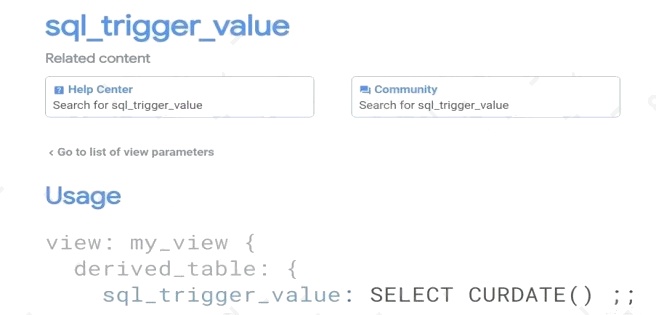
Question 8
A LookML developer has a transactions view with several measures that each perform complex calculations involving
multiple fields. The LookML developer creates an Explore based on the transactions view. The product team wants to
perform further functions on these measures, such as SUM, AVG, MIN, MAX, and RANK. The team wants these further
functions to be performed at different levels of detail: weekly, monthly, and yearly.
How can the LookML developer model these requirements and minimize the amount of code rewriting?
- A. Add measures to the transactions view of type: number to apply the required functions.
- B. Change the existing measures in the transactions view to dimensions, and add measures of the different required types.
- C. Create a constant for each measure so it can be reused across other areas of the LookML project.
- D. Create native derived tables using transactions as the explore_source.
Answer:
D
Question 9
A developer needs to implement three persistent derived tables (PDTs) as described below.
The PDTs need to be refreshed after the daily ETL pipeline adds incremental loads to the underlying tables.
Each PDT is built off of one underlying table in the database (one PDT per table).
The underlying tables for each PDT are updated one after the other, and a new row is added to an ETL log table each
time a table is updated.
Due to the unpredictable nature of the ETL pipeline, each PDT does not refresh at the same time from day to day.
Each PDT takes over an hour to build, and to save on compute costs each PDT should only be refreshed once per day.
How can the developer set up the PDTs according to these requirements?
- A. Create one datagroup tied to all three PDTs that runs when the total row count across all three tables changes.
- B. Create one datagroup tied to all three PDTs that parameterizes the view name for each PDT in the SQL trigger condition.
- C. Create three separate datagroups tied to three PDTs that run when each corresponding table’s row count changes.
- D. Create three separate datagroups tied to three PDTs that run when a new row is added to the ETL log table.
Answer:
D
Question 10
After running the Content Validator, a developer can see the error Unknown field.
Which two changes could cause this issue? (Choose two.)
- A. View name was changed from users to customers.
- B. Field type was changed from number to string.
- C. Model name was changed from e_commerce to reporting.
- D. Explore label was changed from users to customers.
- E. Field name was changed from id to user_id.
Answer:
B E
Question 11
A developer has User Specific Time Zones enabled for a Looker instance, but wants to ensure that queries run in Looker are
as performant as they can be. The developer wants to add a datatype: date parameter to all dimension_group definitions
without time data in a table-based view, so that time conversions dont occur for these fields.
How can the developer determine to which fields this parameter should be applied through SQL Runner?
- A. Open the Explore query in SQL Runner and validate whether removing the conversion from date fields changes the results.
- B. Open the Explore query in SQL Runner to determine which fields are converted.
- C. Use the CAST function in SQL Runner to ensure that all underlying fields are dates and conversions are not applied.
- D. Use the Describe feature in SQL Runner to determine which fields include time data.
Answer:
C
Explanation:
Reference: https://community.looker.com/technical-tips-tricks-1021/how-looker-does-timezones-and-how-to-troubleshoot-
them-25477
Question 12
A developer is building an e-commerce Explore with the following datasets: orders and users. The business user needs to be
able to answer questions about sellers and buyers within the same Explore. Each order in the orders table reports a buyer
and seller ID. The users table has the detailed information about the individual buyer and seller.
How should the Explore be defined to meet this requirement?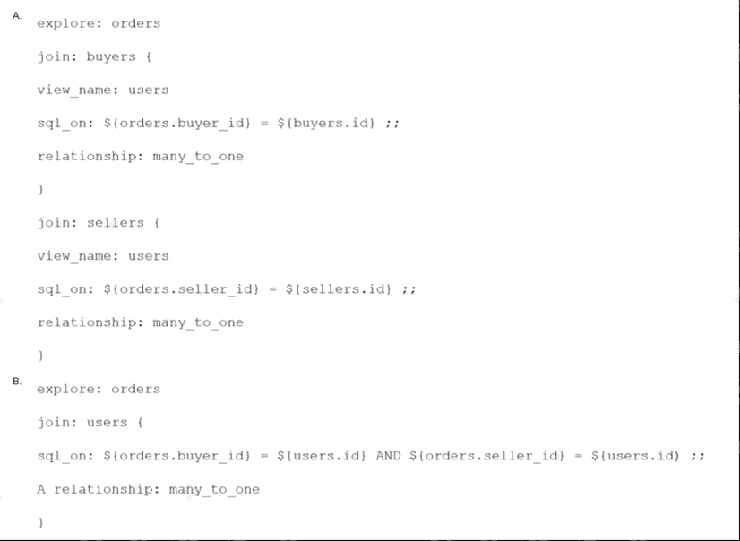
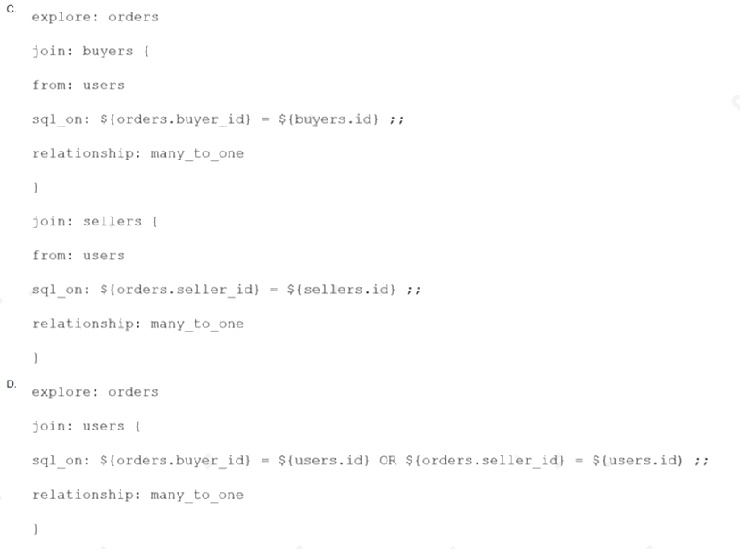
- A. Option A
- B. Option B
- C. Option C
- D. Option D
Answer:
B
Question 13
Two developers are working on adding a new view to a project. Once both developers have finished their work in the view,
the changes will be pushed to production.
Where should the developers write the LookML for this view?
- A. In the master branch, with both users writing to the branch
- B. In one user’s personal branch, with both users writing to the branch
- C. In a new shared branch created from the master branch
- D. In each of their personal branches, with each user writing code separately
Answer:
C
Question 14
A developer needs to model out LookML to convert existing reports into Looker. The existing reports are:
Report 1: A report with order and order_items data, which finds the order with the largest total value of the order_item prices.
Report 2: A report with order and order_items data, which finds the order with the largest total number of products ordered.
Report 3: A report with data on every product, whether or not it has been ordered.
Each database table used is updated in real time as orders are made.
How should the developer construct an Explore using the order_items view as the base view?
- A. Create one persistent derived table to calculate Report 1, create one persistent derived table to calculate Report 2, and join in the products view with a full_outer join.
- B. Create one persistent derived table to calculate Reports 1 and 2, and join in the products view with a full_outer join.
- C. Create one ephemeral derived table to calculate Report 1, create one ephemeral derived table to calculate Report 2, and join in the products view with a left_outer join.
- D. Create one ephemeral derived table to calculate Reports 1 and 2, and join in the products view with a full_outer join.
Answer:
A
Question 15
A LookML developer finishes some LookML work and commits changes in their personal development branch. The
developer is asked to Pull and Merge Other Changes.
What does this indicate?
- A. A change has been deployed to a shared branch.
- B. A change has been committed in another developer’s personal branch.
- C. A change has been committed in another shared branch.
- D. A change has been deployed to production.
Answer:
B
Explanation:
Reference: https://docs.looker.com/data-modeling/getting-started/version-control-and-deploying-changes